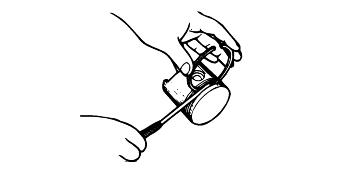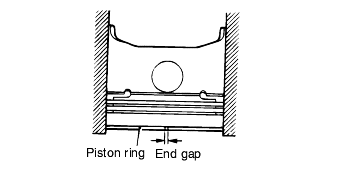Measure the clearance between piston ring and ring groove.

Check each piston for scuffing, scoring, wear and other defects. Replace any piston that is defective.
Check that the piston pin fits in the piston pin hole.
Replace any piston and pin assembly that is defective.
The piston pin must be smoothly pressed by hand into the pin hole (at room temperature)
Check each piston ring for breakage, damage and abnormal wear.
Replace the defective rings.
When the piston requires replacement, its ring should also be replaced.
Measure the clearance between piston ring and ring groove.

Place a piston ring in the cylinder bore and set it square by pushing it down with piston.
Measure the end clearance using a thickness gauge.

Check the bearing surfaces for uneven contact pattern, streaks, scratches, and seizure. If defects are evident, replace. If the surfaces are seriously nicked and seized, check also the crankshaft. If the crankshaft is also damaged,replace the crankshaft or grind to undersize for reuse.

Measure the connecting rod bearing I.D. and crankshaft pin O.D. If the clearance (oil clearance) exceeds the limit, replace the bearing and, if necessary, the crankshaft. Or, grind the crankshaft to an undersize and, at the sametime, replace the bearing with an undersize.
Check the bearing surfaces for uneven contact pattern, streaks, scratches, and seizure. If defects are evident, replace. If the surfaces are seriously nicked and seized, check also the crankshaft. If the crankshaft is also damaged,replace the crankshaft or grind to undersize for reuse.
